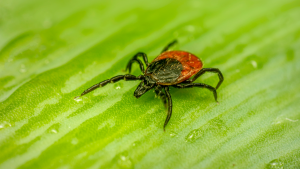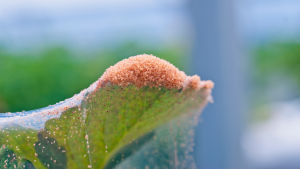We tend to think of bugs as a nuisance, a threat to our property, or even ourselves; especially in the garden. Indeed, there are many pests that can cause a great deal of damage to precious plants & crops, however, most bugs are far more beneficial than harmful – in fact, bugs are incredibly important creatures for maintaining the health of many ecosystems.
Their responsibilities in environment range from a variety of crucial tasks, such as: soil aeration (worms & ants), pollination (bees & butterflies), clean away waste & decay (flies), eliminate weeds (ants), being predators for pests (wasps), among many other roles!
Sadly, the very few pests in the world share the majority of the spotlight – with their negative attention often being applied to the many beneficial bugs of the world. It is important to highlight the beneficial bugs of the world and in the garden, here are 10 beneficial bugs you want to keep around – in no specific order!
1. Ants
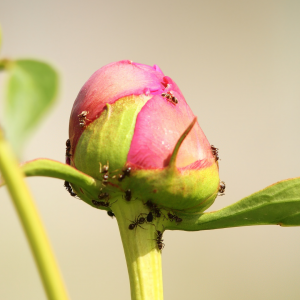
Although the bugs on this list are arranged in no specific order, ants are undeniably one of the most important & beneficial insects on the planet; let alone in the garden.
Benefits: ants are predators of many pests, including: ticks, fleas, plant-eating worms/caterpillars, cutworm eggs, among others. Ants are voracious eaters of many other harmful organisms, like carrion & other waste, and ants are actually big eaters of weed seeds. In fact, ants consume around 95% of weed seeds in yards & gardens! Lastly, ants are also pollinators for certain plant species, above ants can be seen pollinating some peonies, as they drink the flowers’ nectar.
Promotion: if you want to promote ants in the garden, it is important to not use any chemical pesticides or poisons. Plant flowers that can attract certain any species like peonies (sugar ants), roses, and hostas to name a few.
2. Ladybugs
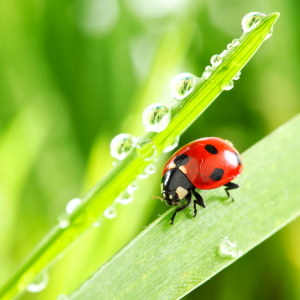
You may have heard that ladybugs are beneficial insects for the garden, as they have become very popular for biological pest control in recent years. You can actually purchase ladybugs by the hundreds to release into your garden or greenhouse to control pests naturally.
Benefits: ladybugs act as predators in gardens and mainly feast on aphids, as 1 ladybug can eat around 5,000 aphids in its lifetime. They also have an appetite for: thrips, mites, whitefly, mealybugs, weevils, leafhoppers, grape rootworms, scale, and others.
Promotion: plant flowers that attract ladybugs, such as: geraniums, marigolds, calendulas, and cosmos. Ladybugs also enjoy pollen, so any “pollen-rich” plant will help to attract them. If purchasing ladybugs, it may be a good idea to provide some “starter” food for them, like raisins. Soak the raisins for a few minutes, then cut them open and give them to the ladybugs – this will give them a nice meal before venturing out into the garden to hunt.
It is also important to avoid spraying pesticides, or anything that relies on leaving behind a residue, as this will harm the ladybugs. See this article for more information on why chemical residues are bad for bugs.
3. Hornets & Wasps
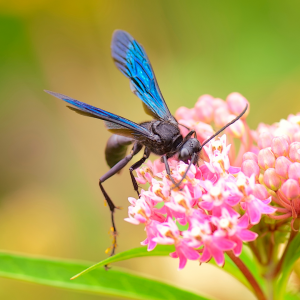
Now hornets & wasps technically count as two different types of bugs, however, all hornets can be wasps, but not all wasps can be hornets; so they will count as one for the purposes of this article. Perhaps, an unlikely candidate for being beneficial, but these insects are actually very helpful in the garden.
Benefits: hornets & wasps are predators of many pests. Parasitic wasps are perhaps one of the most well known beneficial predators (available for purchase like ladybugs), but hornets, like yellow-jackets, are also beneficial. They also do some pollinating, although not as efficient as bees (the fuzzy coats of bees are more apt to collecting pollen).
Promotion: avoid spraying pesticide poisons that apply a residue that sticks behind on plants, as when the hornets or wasps visit plants they can be exposed to toxic residues. Do not disturb their nests or hives, often times, hornets & wasps will leave people alone if left alone.
Unlike some of the other beneficial bugs on this list, hornets & wasps can become dangerous, if they nest in high-traffic areas (i.e. doorways or decks) and if people with allergies become close to nests. In those cases, it may be wise to remove the nest. See this article for how to do so safely, without using poisons.
4. Earwigs
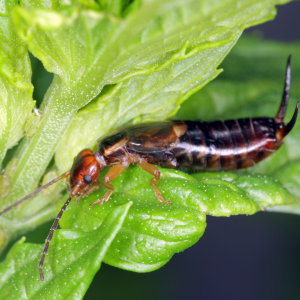
Here is an insect you definitely did not imagine seeing would end up on this list! Earwigs can actually be beneficial for gardens and are not dangerous pests to humans (even though their tails may seem frightening).
Benefits: earwigs are predators of a variety of pests that damage plants, such as: chinch bugs, caterpillar eggs, and aphids among others. They are also important feeders of decaying organic matter, like dead plants & insects and even decaying wood, cleaning up gardens.
Promotion: earwigs love to nest in moist or damp wood and seek out dark, damp areas to nest. They are nocturnal and will come out at night to hunt for pests. Earwigs like dense & thick underbrush to hide & hunt in, you can “corral” them to certain areas, like leaf piles or wood piles on the fringes/borders of your garden.
*Note* earwigs can be a double-edged sword, as they may start to feed on living plants if they run of out other food sources. It’s important to not overreact as their damage is usually minimal.
5. Spiders
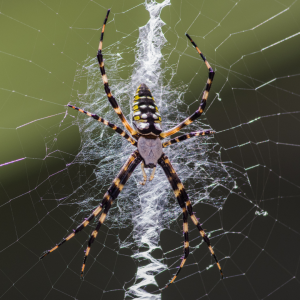
It is well known that spiders are great predators to keep around, and they are one of the most common arachnids we come into contact with. Like with hornets & wasps, if spiders are left alone they are usually harmless. Depending on where you live, there are typically only a very select few spiders that are dangerous to humans; the vast majority, especially in the garden, are harmless!
Benefits: the main benefit spiders provide are their hunting skills for pests, feeding on a plethora of pests from the smallest aphids to the largest beetles & locusts. Another overlooked benefit of spiders is the fear they cause to insects, you read that right, even bugs are scared by spiders too! Take grasshoppers for example, they will avoid areas where spiders spin webs or have hunted in the past. Spiders can be effective even if they do not catch very many pests, because their presence alone deters would-be pests.
Promotion: first & foremost, do not apply chemicals to your garden if you want spiders to stick around. Mulch is known to invite spiders and provide ample habitat for their hunting grounds, simply pile mulch at least 2 in. high. Trees can help provide a great home for spiders, and a variety of native wildflowers is important to draw in spiders. It goes without saying that leaving their webs intact, where they are not in the way, is important too.
6. Ground Beetles
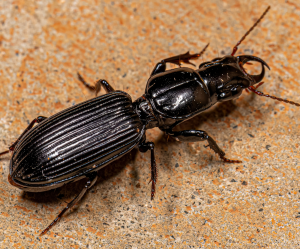
There is no one specific species of ground beetle, this term actually refers to an entire family of beetles. The ground beetle family as over 2,500 species in North America alone. Above, a member of the ground beetle family and they are all very important bugs to have in the garden. If you are looking to identify whether or not you have ground beetles, think back to a time where you moved a rock and saw black iridescent beetles scurrying away; those count at ground beetles.
Benefits: a common theme here, ground beetles are big predators of a variety of garden pests. Ground beetles are another destroyer of aphids but also hunt grubs and maggot eggs. In fact, they spend most of their time in the soil, devouring all kinds of pests that may harm plant roots; able to kill as much as 90% of cabbage root maggots in a field. Though they prefer soil environments, some species will climb trees to hunt for tent caterpillars.
Promotion: do not apply pesticide ground or soil treatments, these applications will contaminate soils for upwards of a few decades and kill off all of the beneficial ground beetles. Simply leaving their rock habitats alone and letting these insects be, is a great step to promoting their presence in the garden.
7. Dragonflies
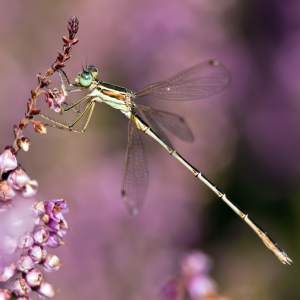
Dragonflies are incredible creatures and some of the most important insects in the fight against mosquitoes! Their eyes contain over 28,000 facets which allow them to spot mosquitoes, and other prey, from over 25 feet away. Dragonflies can also reach speeds of 60 miles per hour when chasing down pests. You definitely want to cultivate a friendship with these beneficial insects in the garden.
Benefits: the main benefit of dragonflies, as described above, is their prowess in hunting and the many different pests they hunt. Dragonflies are one of the most skillful and successful predators on this list, boasting a success rate of 95% for catching prey. Another benefit of dragonflies is that they are used as “bioindicators”, which means if dragonflies are present in an ecosystem, that ecosystem is healthy.
Promotion: dragonflies lay their eggs in freshwater and their larva need a sufficient amount of water (at least 2 feet) to develop. Adding a pond or small water area to your garden would be a great way to attract these amazing beneficial insects. Simply add some aquatic plants to your pond and allow for some sun-bathing areas for the adult dragonflies, and you’ll be good to go!
8. Flies
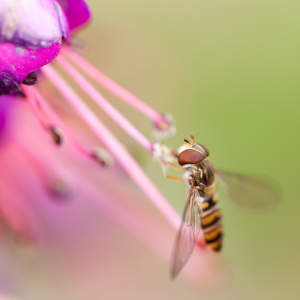
Perhaps another curveball on this list, but flies are actually beneficial to have around in the garden – at least certain species. Flies as a whole typically get a bad rap, and rightfully so, due to certain species’ abilities to spread disease; but some flies, like syrphid flies, are beneficial and help protect plants from pests.
Benefits: most of the beneficial flies in the garden attack would-be plant pests, like aphids. The long-legged aphid midges (with small, bright orange larvae) are great predators of aphids. Syrphid flies, also known as hover flies (pictured above), consumer aphids voraciously. Other fly species, like gray tachinid flies, feast on tent caterpillars and many other pests.
Promotion: in order to help promote these beneficial flies for free pest control, it is important to not spray poisons or synthetic chemicals. Many of these flies frequently visit flowers for nectar and they can be killed if toxic residues are left behind on plants. Otherwise, if there is prey for the flies to hunt, the flies will come around and protect the garden.
9. True Bugs
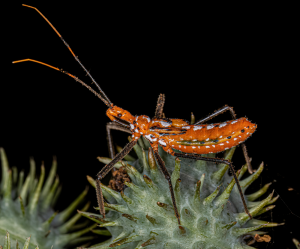
Did you know there was an entire group of insects called the “True Bugs”? One of the orders of insects is called Hemiptera and is home to a variety species of insects to differentiate themselves from other types of “bugs”. These bugs have needle-like mouths used for sucking out the juices of their prey, like the assassin bug pictured above.
Benefits: were you going to guess that main benefit of these bugs was hunting? If so, cheers to you! The beneficial true bugs are mostly hunters that prey on many would be garden pests. What sets them apart from other members of this list is that many of the smaller true bugs inhabit the insides of flowers, ridding them of thrips and other pests. Damsel bugs & big-eyed bugs, are both notable predators of chinch bugs and others.
Promotion: a wide variety of flowers will help to attract as many different true bugs as possible. For example, smaller flowers like dill, parsley, catnip, and herbs will be great homes to tinier parasitic insects. Consider leaving “weeds” like dandelions or goldenrod to attract more types of true bugs (these “weeds” are actually beneficial for bees too).
10. Lacewings
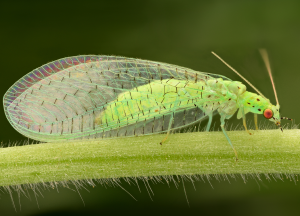
Last, but definitely not least, lacewings are very important insects to have in the garden. Both the adults and their larvae are major predators of aphids and have earned the nickname “aphid lions”. Lacewings are also one of the few bugs on this list available for purchase.
Benefits: in addition to aphids, lacewings hunt many other pests, such as: caterpillars, thrips, leafhoppers, spider mites, and many different insect eggs. Lacewings have two traits that make them so desirable for pest control: they are aggressive, and they are always hungry. This means lacewings will always be hunting for their next meal and their aggressiveness means they will be more willing to take on hardier or tougher pests!
Promotion: it is important to not apply harmful chemicals or synthetic pesticides to your plants, if you would like to promote lacewings. Lacewings attach their eggs along the leaf veins of plants, where they are susceptible to pesticide exposure.
Final Thoughts
If you would like to promote any or most beneficial bugs in the garden, the main “secret” is to simply not use synthetic pesticides. That act alone will drive beneficial insect growth and help foster a healthier garden overall.
Remember insects found in the garden, the sound of insects buzzing around when you walk outside, are incredibly important indicators of a healthy environment. If you rarely see bugs on plants or it is quiet when walking in the garden, those are signs of an unhealthy ecosystem.
No one wants pests to eat their crops, HOWEVER, if you choose to spray poisons and no pests are nibbling on your plants – why on Earth would you want to eat those same plants?
Want to learn about even more beneficial bugs in the garden? Read chapter 37 “Lawn Maintenance” in the Best Control II free online manual by clicking this link.
Thank you for reading and happy gardening!
-Gage


